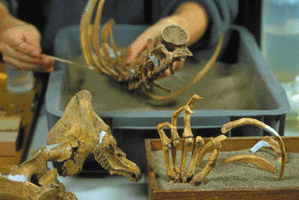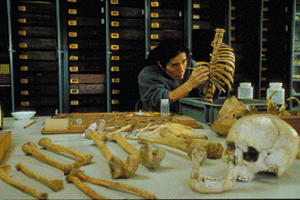
− Gen Suwa −
Ph.1 A general view of the Tsukumo shell mound,
photograph probably taken in 1919.
Ph.2 Uncovered condition of individuals 18, 19 and 20,
in Hasebe's excavation of December 1919 at Tsukumo.
Ph.3 A close up of individual 19 of
Hasebe's December 1919 excavation.In this exhibit, we attempt to replicate the spatial positioning of buried human skeletal remains of the Jomon period, as if to observe the burial in place within the ground. We present two burials, one a well preserved individual from the Tsukumo shell mound, and the other a mixed burial of over 10 individuals from the Hobi shell mound.
Ph.4 Uncovering the 'group burial A' at Hobi shell mound,
in Suzuki's excavation of 1965.
The Tsukumo skeleton is registered as UMUT-131643, also catalogued as Tsugumo ('19.12.) number 19, an adult female skeleton. The catalogue name indicates that it is skeleton number 19 of K. Hasebe's excavation in December of 1919. Unfortunately, no details of the excavation are available today, but some of Hasebe's specimens from Tsukumo are referred to in his brief accounts of Jomon burial and tooth extraction practices. Among Hasebe's unpublished and unarchived documents, however, there exist some old photographs, 31 in total, labeled Tsukumo. Included within this set of photographs is the skeleton Tsugumo ('19.12.), so we can be fairly sure that this whole set was taken in December 1919. The photograph indicates that the skeleton was buried in flexed position, as often the case with Jomon burials, with the torso facing upward and the bent legs angling slightly to the right side.
Ph.5,6 A positional reconstruction of the Tsugumo 19 burial, physical anthropologist K. Sakaue takes on the challenge.
In this exhibit we attempt a positional reconstruction of the burial in its estimated initial state. Considerable expertise is required in such an undertaking. Small seemingly undiagnostic pieces are scrutinized and assembled into place. Chemical preservative is applied to strengthen ill-preserved bone internally and externally. Gaps are filled with sculptured resin where necessary. We then glue together clusters of small bones as with the hand, or reconstruct complex 3-dimensional structures as with the pelvis or thorax, eventually shaping the entire burial. An ordinary skeleton put together as a laboratory specimen is typically linked and held in position by metal supports and joints. Such locally damaging procedures cannot be applied to invaluable prehistoric remains.


Ph.7 Gridding the 'group burial A' at Hobi.The skeletal collection from the Tsukumo shell mound (Okayama Prefecture), in as early as 1920, totalled over 170 individuals. This continues, to the present day, to be one of the most important skeletal series of the Jomon period. At the time of active excavation, especially from 1918 to 1919, three anthropologist and anatomists, K. Ogushi, K. Kiyono and Hasebe, excavated in turns at Tsukumo, seemingly competitively. This resulted in the early acquisition of the huge collection, unrivalled at that time, which led to Kiyono's statistically valid characterization of the Jomon people, the first such attempt in Japanese physical anthropology. A portion of the Tsukumo skeletal collection is housed in the Department of Anthropology and Prehistory, The University Museum, The University of Tokyo, consisting predominantly of the 25 or so individuals collected by Hasebe in his two excavations in 1919.
The Hobi skeletal material on exhibit is that from 'group burial A' of H. Suzuki's 1965 excavation. Again, although published details are not available, photographs and approximate plots from the excavations are stored in good condition. The Hobi shell mound (Aichi Prefecture), together with the nearby Ikawazu and Yoshigo shell mounds is famous for the extensive Jomon skeletal series that it has yielded. It has been known since 1904, and collection of skeletal remains commenced in 1922 by anatomist Y. Koganei. We house in the Department of Anthropology and Prehistory these remains as well as those excavated around 1941 and in the 1960s. The 'group burial A' consists of over 10 individuals, without any obvious clustering by individual. In this exhibit, we reconstruct, to the extent possible, the original buried configuration. Mixed burials of similar scale are rare in the Jomon period, but an example found at Ikawazu shell mound in 1984 is well documented.